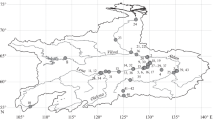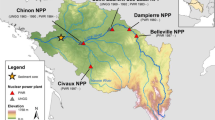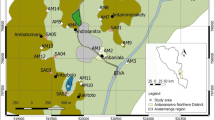Abstract
This study was focused on the 3H activity levels in the unique “tritium valley” around the Mohelno reservoir, which receives outlet cooling waters from the Dukovany nuclear power plant. Tritium activity levels above the background reference value were found in water from the reservoir and from the effluent part of the Jihlava water, in air moisture and in plant tissues tissue free water tritium (TFWT), and non-exchangeable organically bound tritium (NE-OBT). These zones were discernible that had noticeably different TFWT and NE-OBT values: (1) littoral zones, (2) slopes above the reservoir, (3) plateaus above the reservoir/river.



Similar content being viewed by others
References
Baglan N, Alanic G, LeMeignen R, Pointurier F (2011) A follow up of the decrease of nonexchangeable organically bound tritium levels in the surroundings of a nuclear research center. J Envir Radioact 102:695–702
Diabaté S, Strack S (1993) Organically bound tritium. Health Phys 65:698–712
Guénot J, Bélot Y (1984) Assimilation of 3H in photosynthesizing leaves exposed to HTO. Health Phys 47:849–855
Pointurier F, Baglan N, Alanic G (2004) A method for the determination of low level organic-bound tritium activities in environmental samples. Appl Radiat Isot 61:293–298
Baumgartner F, Donhaerl W (2004) Non-exchangeable organically bound tritium (OBT): its real nature. Anal Bioanal Chem 379:204–209
Boyer C, Vichot L, Fromm M, Losset Y, Tatin-Froux F, Guétat P, Badot PM (2009) Tritium in plants: a review of current knowledge. Environ Exp Bot 67:34–51
Hamby DM, Palmer TS (2001) Analysis of an internal kinetic model for free and bound tritium. Health Phys 81:426–437
Hunt J, Bailey T, Reese A (2009) The human body retention time of environmental organically bound tritium. J Radiol Prot 29:23–36
International Commission on Radiological Protection (1997) Report on the task group on reference man. Publication 78. Annals of the ICRP/ICRP Publication
Straume T, Carsten AL (1993) Tritium radiobiology and relative biological effectiveness. Health Phys 65:657–672
Okada S, Momoshima N (1993) Overview of tritium: characteristics, sources and problems. Health Phys 65:595–608
Steinhauser G (2014) Fukushima’s forgotten radionuclides: a review of the understudied radioactive emissions. Environ Sci Technol 48:4649–4663
Matsumoto T, Maruoka T, Shimoda G, Obata H, Kagi H, Suzuki K, Yamamoto K, Mitsuguchi T, Hagino K, Tomioka N, Sambandam C, Brummer D, Klaus PM, Aggarwal P (2013) Tritium in Japanese precipitation following the March 2011 Fukushima Daiichi Nuclear Plant accident. Sci Total Environ 445–446:365–370
Povinec PP, Aoyama M, Biddulph D, Breier R, Buesseler K, Chang CC, Golser R, Hou XL, Ješkovský M, Jull AJT, Kaizer J, Nakano M, Nies H, Palcsu L, Papp L, Pham MK, Steier P, Zhang LY (2013) Cesium, iodine and tritium in NW Pacific waters-a comparison of the Fukushima impact with global fallout. Biogeosciences 10:5481–5496
Janovics R, Bihari A, Papp L, Dezso Z, Major Z, Sarkany KE, Bujtas T, Veres M, Palcsu L (2013) Monitoring of tritium, Co-60 and Cs-137 in the vicinity of the warm water outlet of The Paks Nuclear Power Plant, Hungary. J Envir Radioact 128:20–26
Kollo Z, Palcsu L, Major Z, Papp L, Molnár M, Ranga T, Dombovari P, Manga L (2011) Experimental investigation and modelling of tritium washout by precipitation in the area of the nuclear power plant of Paks, Hungary. J Environ Radioact 102:53–59
Svetlik I, Fejgl M, Malátová I, Tomaskova L (2014) Enhanced activities of organically bound tritium in biota samples. Appl Radiat Isot 93:82–86
Kakiuchi H, Akata N, Hasegawa H, Ueda S, Tokonami S, Yamada M, Hosoda M, Sorimachi A, Tazoe H, Noda K, Hisamatsu S (2012) Concentration of 3H in plants around Fukushima Dai-ichi Nuclear Power Station. Sci Rep 2:947
Acknowledgments
This study was conducted with funding by the institutional funding of Nuclear Physics Institute AS CR (RVO61389005) and by the Czech Ministry of Interior (Project MV-25972-39/OBVV-2010).
Author information
Authors and Affiliations
Corresponding author
Rights and permissions
About this article
Cite this article
Kořínková, T., Svetlik, I., Fejgl, M. et al. Occurrence of organically bound tritium in the Mohelno lake system. J Radioanal Nucl Chem 307, 2295–2299 (2016). https://doi.org/10.1007/s10967-015-4443-4
Received:
Published:
Issue Date:
DOI: https://doi.org/10.1007/s10967-015-4443-4




